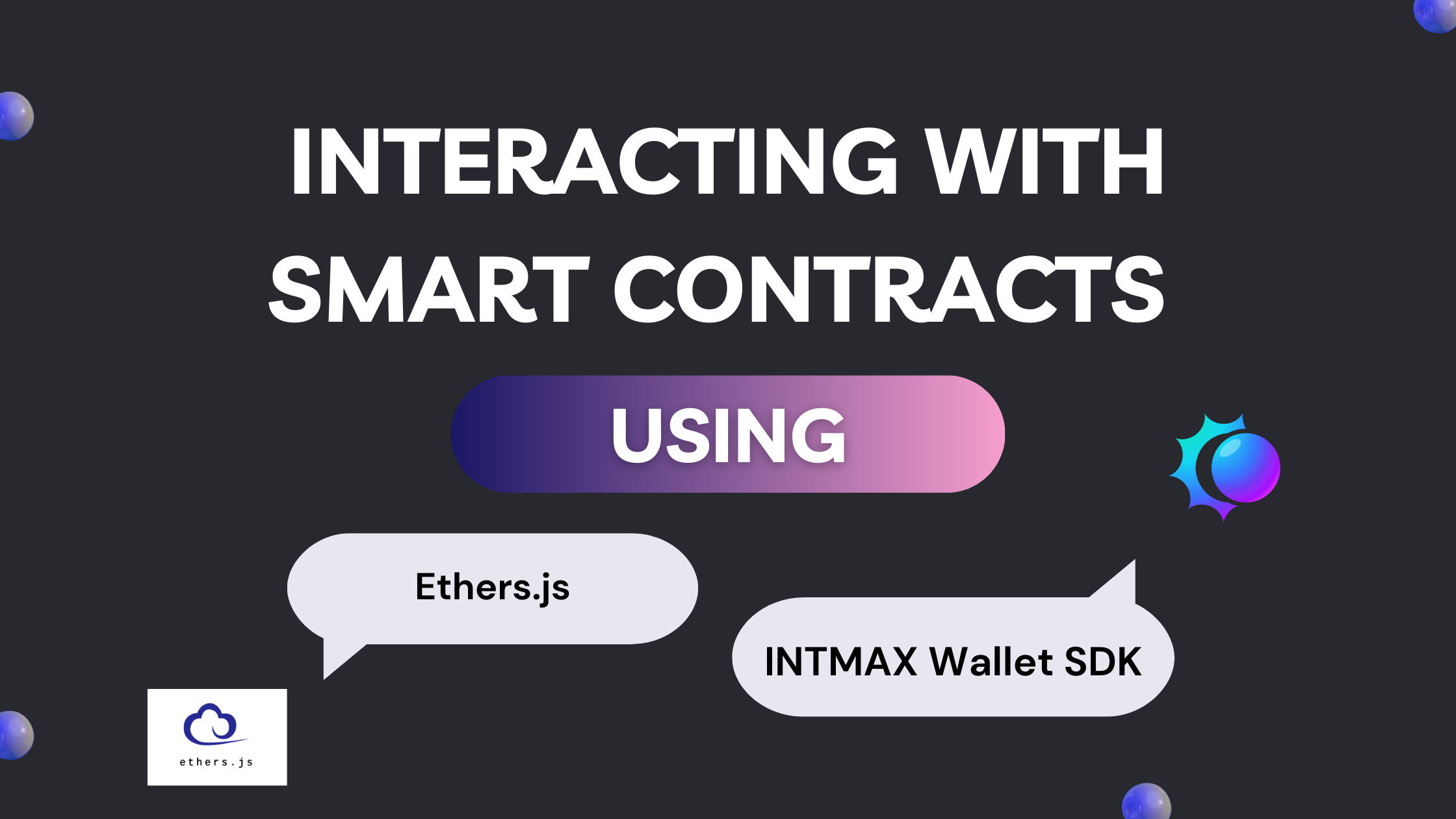Interacting with Smart Contracts Using INTMAX Wallet SDK and Ethers.js
 Glory Praise Emmanuel
Glory Praise Emmanuel
Smart contracts have revolutionized the way decentralized applications (DApps) operate by enabling automated, trustless agreements on the blockchain. To build robust DApps, developers often leverage powerful tools like Ethers.js and INTMAX Wallet SDK. In this tutorial, we'll walk you through how to install these libraries, connect to a smart contract, interact with it, and check the balance of an address using a practical example.
Prerequisites
Before we begin, ensure you have the following:
Node.js and NPM are installed on your machine.
Frontend dApp built with React.js/Vue.js/Angular.
Familiarity with Ethereum and smart contracts.
Installing Dependencies
We'll need to install Ethers.js and INTMAX Wallet SDK to interact with the blockchain and manage wallet connections.
1. Install INTMAX Wallet SDK
INTMAX Wallet SDK facilitates seamless wallet integration into your DApp.
npm install intmax-walletsdk
2. Install Ethers.js
Ethers.js is a library for interacting with the Ethereum blockchain. It provides a simple and secure way to communicate with smart contracts.
npm install ethers
Connecting to INTMAX Wallet
To interact with a smart contract, users need to connect their wallets. We'll use INTMAX Wallet SDK to handle wallet connections.
Initialize the INTMAX DApp Client
First, set up the INTMAX DApp client with the necessary metadata, specifying the wallet URL and other details:
import { intmaxDappClient, ethereumProvider } from "intmax-walletsdk/dapp";
const DEFAULT_WALLET_URL = "https://wallet.intmax.io";
const DEFAULT_DAPP_ICON = `${window.location.origin}/logo.png`; //directory of logo
const DAPP_METADATA = {
name: "My Brand Name",
description: "This is a simple example of how to use the SDK DApp client.",
icons: [DEFAULT_DAPP_ICON],
};
const createSdk = (walletUrl) => {
return intmaxDappClient({
wallet: { url: walletUrl, name: "INTMAX Wallet", window: { mode: "popup" } },
metadata: DAPP_METADATA,
providers: { eip155: ethereumProvider() },
});
};
const sdk = createSdk(DEFAULT_WALLET_URL);
Handle Wallet Connection
Create a function to connect the user's wallet and retrieve their accounts:
const handleConnect = async () => {
const intmaxWalletProvider = sdk.provider("eip155:137"); // 137 is Polygon mainnet network
await intmaxWalletProvider.request({ method: "eth_requestAccounts", params: [] });
const accounts = await intmaxWalletProvider.request({ method: "eth_accounts", params: [] });
};
The handleConnect function requests account access from the user's wallet and updates the state with the connected accounts.
Interacting with the Smart Contract
We'll use Ethers.js to interact with the smart contract. This includes reading data from the contract and sending transactions.
Define the Smart Contract ABI and Address
First, define the ABI (Application Binary Interface) and the smart contract address. The ABI defines the smart contract's interface, and the contract address points to its location on the blockchain.
import { ethers, Contract } from 'ethers';
const abi = [
// ... (Your ABI here)
];
const contractAddress = "CONTRACT ADDRESS";
Create a Contract Instance
Initialize the contract instance using Ethers.js:
const currentAccount = accounts[0]; // connected wallet address from above
const provider = new ethers.JsonRpcProvider('https://polygon-mainnet.infura.io/v3/YOUR_INFURA_PROJECT_ID');
const signer = new JsonRpcSigner(provider, currentAccount);
const contract = new ethers.Contract(contractAddress, abi, signer);
Reading from Smart Contract
In this section, we'll focus on reading data from the smart contract. Specifically, fetch vote counts for different clubs using the smart contract's getClubVotes function.
const fetchVoteCounts = async () => {
const votes = await contract.getClubVotes(clubId);
console.log("Votes:", votes.toString());
}
The getClubVotes function from the smart contract is called for each club to retrieve the number of votes each club has received.
By using this approach, we can fetch data from the blockchain and display it to users.
Writing to Smart Contract
Now, let’s explore how to interact with the smart contract by writing to it. Specifically, we’ll focus on casting a vote for a club using the vote function of the contract.
const handleVote = async (club) => {
// Connects with wallet account
if (accounts.length === 0) await handleConnect();
try {
// Sending a transaction to vote for the selected club
const result = await intmaxWalletProvider.request({
method: "eth_sendTransaction",
params: [{
from: currentAccount,
to: contractAddress,
data: contract.interface.encodeFunctionData("vote", [clubId]),
gasLimit: 300000,
}]
});
// Check the new vote
console.log("Result:", result);
} catch (error) {
console.error("Error voting:", error);
}
};
The handleVote function interacts with the smart contract to cast a vote. Before any transaction can be made, the wallet must be connected using the intmaxWalletProvider. The vote function from the smart contract is invoked with the selected club’s ID, encoding the function call with ethers to create a transaction. The transaction is sent using the INTMAX wallet’s eth_sendTransaction method, ensuring the vote is cast on-chain. Remember that a contract instance was created above and is being used here including the provider and signer.
Checking Address Balance
To check the balance of a specific address, use Ethers.js as follows:
const checkAccountBalance = async () => {
try {
const balanceInWei = await provider.getBalance(currentAccount);
const balance = ethers.formatEther(balanceWei);
console.log("Balance in Polygon:", balance);
} catch (error) {
console.error("Error fetching balance:", error);
}
};
We use getBalance to fetch the balance of the address on the Polygon network, converting the result from wei (the smallest unit) to ether. Note, that the balance gotten would be the balance of whatever native token of the selected network.
Complete Code Example
Below is the complete React component integrating INTMAX Wallet SDK and Ethers.js to interact with a smart contract and check the balance of an address.
Conclusion
In this tutorial, we demonstrated how to use INTMAX Wallet SDK and Ethers.js to interact with a smart contract by reading data and writing transactions. We explored how to:
Read from the contract to check vote counts and to check address balances.
Write to the contract by casting votes through a wallet interaction.
By following these steps, you can build more complex and feature-rich decentralized applications that leverage the power of blockchain technology.
Remember to replace placeholder values like YOUR_INFURA_PROJECT_ID and ensure your smart contract's ABI and addresses are correctly configured.
Happy coding!
Quick Links
Learn more about Intmax Wallet SDK: intmax-wallet.gitbook.io/intmax-walletsdk
Live demo: https://sports-voting-demo.vercel.app/
Full code in Github Repo: https://github.com/emmaglorypraise/Sports-Voting-Demo
Reach out to me on Twitter if you have any questions.
Subscribe to my newsletter
Read articles from Glory Praise Emmanuel directly inside your inbox. Subscribe to the newsletter, and don't miss out.
Written by

Glory Praise Emmanuel
Glory Praise Emmanuel
Glory Praise Emmanuel is a Frontend Engineer, Technical writer and Blockchain Developer based in Nigeria. She is passionate about providing solutions with technology and making the world a better place. She is interested in Open Source and community building.